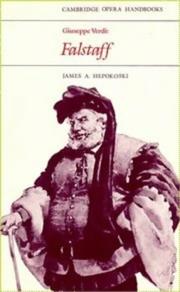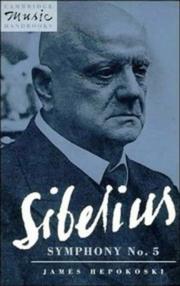| Listing 1 - 4 of 4 |
Sort by
|

ISBN: 0521280168 Year: 1983 Publisher: Cambridge ; New York, NY : Cambridge University Press,
Abstract | Keywords | Export | Availability | Bookmark
 Loading...
Loading...Choose an application
- Reference Manager
- EndNote
- RefWorks (Direct export to RefWorks)

ISBN: 0521409586 0521401437 9780521401432 9780521409582 9780511620188 0511620187 Year: 1993 Publisher: Cambridge Cambridge University Press
Abstract | Keywords | Export | Availability | Bookmark
 Loading...
Loading...Choose an application
- Reference Manager
- EndNote
- RefWorks (Direct export to RefWorks)
Sibelius's Fifth is one of the great late-Romantic symphonies. In this searching account, based on a wealth of new information, James Hepokoski takes a fresh look at the work and its composer. His findings have implications beyond Sibelius himself into the entire repertory of Post-Wagnerian symphonic composition. The early chapters place the Fifth Symphony squarely within the general culture of European musical 'modernism' and focus in particular on the problem of the clash of that culture with the more radical 'New-Music' experiments of an emerging younger generation of composers. Subsequent chapters include a probing consideration of Sibelius's style and meditative aesthetic; an account of how the symphony was composed; and a descriptive analysis of the final, familiar version. The book concludes with a discussion of the composer's own prescribed tempos for the Fifth Symphony, along with a comparison of several different recordings.
Sibelius, Jean, --- Vijfde symfonie (Sibelius). --- Sibelius, Jean. --- Symphonies (Sibelius, Jean).
Book
ISBN: 9461660049 9789461660046 905867715X 9789058677150 9058678229 9789058678225 Year: 2009 Publisher: Leuven Leuven University Press
Abstract | Keywords | Export | Availability | Bookmark
 Loading...
Loading...Choose an application
- Reference Manager
- EndNote
- RefWorks (Direct export to RefWorks)
The tone of the debates among Caplin, Hepokoski, and Webster (in the form of comments on each author''s essay and then responses to the comments), though tactful, is obliquely blunt and tendentious; like the best of tennis pros, each author strives to serve an ace and defends the net against a passing shot (with Caplin, the ace is for formal function; with Hepokoski for Sonata Theory and dialogic form; with Webster for multivalent analysis). But we can trust that this provocative exchange will thoroughly invigorate discussions about classical form and encourage diverse approaches to its analys
Digital

ISBN: 9781400859597 9780691602677 Year: 2014 Publisher: Princeton, N.J. Princeton University Press
Abstract | Keywords | Export | Availability | Bookmark
 Loading...
Loading...Choose an application
- Reference Manager
- EndNote
- RefWorks (Direct export to RefWorks)
| Listing 1 - 4 of 4 |
Sort by
|

 Search
Search Feedback
Feedback About UniCat
About UniCat  Help
Help News
News